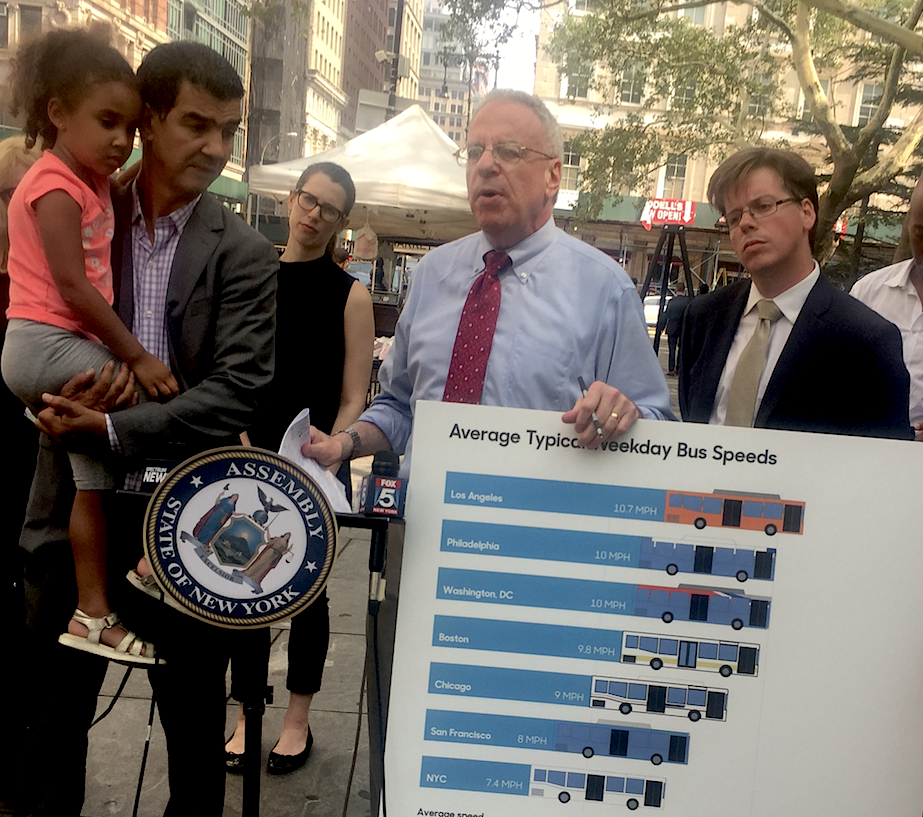The sorry state of NYC subways may be getting most of the attention recently, but bus service needs improvements in speed and reliability just as badly, if not more. In fact, the decline of transit ridership in the city is mainly the result of people abandoning the bus, not the subway.
MTA Chairman Joe Lhota has said a comprehensive plan to fix the subways is in the works. Now dozens of New York City representatives in the state Assembly are calling for a bus plan as well.
In a letter to Lhota today, Assembly corporations and authorities chair Jeff Dinowitz and 44 of his colleagues demand a "comprehensive plan" to fix the bus system "within six months" [PDF].
At a press event this morning, Dinowitz said he hoped the city's bus riders aren't left behind as Albany officials turn their to the transit system.
"The problem -- which nobody seems to be discussing, because it's kind of been pushed aside, but it's crucial to literally millions of New Yorkers in each and every borough -- is the issue of deteriorating bus service in this city," Dinowitz said.
The letter states:
Bus ridership has been steadily declining, and it is not because of lack of demand. Average bus speeds in New York City are seven miles per hour, and as slow as four miles per hour in congested areas such as Midtown Manhattan, Downtown Brooklyn, and Jamaica, Queens. Some of our most frequent constituent complaints are about the (poor) quality of bus service, from lateness and overcrowding to schedules that reflect neither user demand nor rider experience.
The letter recommends fare technology enabling all-door boarding, transit signal priority, bus route redesigns, dedicated bus lanes, and improved bus stops -- picking up on the plan released by the Bus Turnaround Coalition last year.
Average bus speeds in NYC are just 7.4 mph, lower than any other major city in the country. Even as rider frustration with the subways escalated in the first half of the year, bus ridership dropped 2 percent from the first half of 2016, compared to a mere .04 percent decline in subway ridership.
In May, Dinowitz and 66 colleagues called on Governor Cuomo to accelerate the implementation of transit signal priority and all-door boarding technology [PDF]. Cuomo never responded.
NYC DOT did release a report promising to get TSP operational on 20 bus routes by 2020. But there are dozens of high ridership routes that stand to benefit significantly from the technology, and the only cost involved is planning -- the hardware is already in place.
"We cannot wait until 2020 to improve condition for people who are suffering now," the lawmakers write in their letter.
"At least in my office, I actually get more complaints about bad bus service than bad subway service," Dinwoitz said. "The subways need improvement, but it's not just about the subways."
One policy that would speed up most bus routes overnight is congestion pricing. Bus ridership skyrocketed in London after the implementation of a congestion charge in 2003, as surface transit speeds increased immediately and more street space was carved out for dedicated transit lanes.
Dinowitz was one of the big political opponents of congestion pricing in 2008, when the Bloomberg administration pushed for it as the centerpiece of the PlaNYC sustainability agenda. Today, Dinowitz sounded much more open to the idea, if not quite ready to endorse it.
"The composition of the conference is not the same as it was nine years ago, so there might be different opinions now, there may be a different plan," he said. "I was not a supporter of congestion pricing last time around, I’m not necessarily supportive this time around, but I think all options, as they say, need to be on the table."
Asked by NY1's Zack Fink whether the Assembly planned to hold an oversight hearing on the MTA, Dinowitz said it might happen after Labor Day. "Whatever we do, want to make sure people are paying attention and that we have maximum input," he said.






